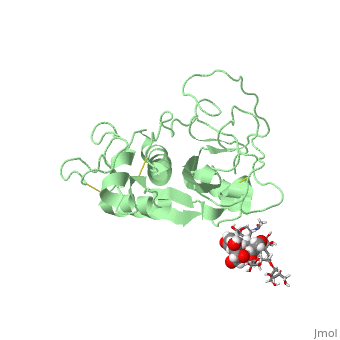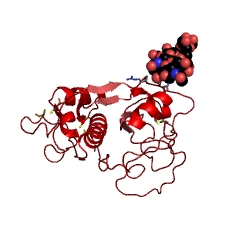Bromelain
From Proteopedia
Bromelain is a protein extract derived from the stems of pineapples.The extract has a history of folk medicine use. As a culinary ingredient, it may be used as a meat tenderizer. Bromelain may refer to either of two protease enzymes extracted from the plants of the family Bromeliaceae, or it may refer to a combination of those enzymes along with other compounds produced in an extract. Although tested in a variety of research models for its possible efficacy against diseases, bromelain has no established research evidence as a nutraceutical or drug.Limited evidence exists for possible effectiveness of a product used to reduce pain from osteoarthritis that combines bromelain with trypsin and rutin.
Image of ProteinFunctionAs a potential anti-inflammatory agent, it may be useful for treating arthritis. Systemic enzyme therapy (consisting of combinations of proteolytic enzymes such as bromelain, trypsin, chymotrypsin, and papain) has been investigated in Europe to evaluate the efficacy of proteolytic enzymes in the treatment of breast, colorectal, and plasmacytoma cancer patients[1] Bromelain is one of the most popular proteases to use for meat tenderizing. HistoryPineapples have a long tradition as a medicinal plant among the natives of South and Central America. The first isolation of bromelain was recorded by the Venezuelan chemist Vicente Marcano in 1891 by fermenting the fruit of pineapple.In 1892, Russell Henry Chittenden, assisted by Elliott P. Joslin and Frank Sherman Meara, investigated the matter more completely,and called it 'bromelin'. Later, the term 'bromelain' was introduced and originally applied to any protease from any member of the plant family Bromeliaceae. Temperature stabilityAt the optimum temperature, the enzyme acts the fastest, but (at least the fruit variant) is destroyed within few minutes. After an hour at 50 °C (122 °F), 83% of the enzyme remains, while at 40 °C (104 °F), practically 100% remains. As a result of this, the optimum temperature for maximum cumulated activity over time is 35-45 °C. At room temperature, the enzyme can survive at least a week even under multiple freeze-thaw cycles. How it worksBromelain is a cysteine protease. The contains a cysteine residue. A neighboring histidine increases the ionization of the cysteine, making it a better nucleophile. 3D Structures of bromelainUpdated on 16-April-2019 1w0q - pineapple - model References
| ||||||||||||||||||


